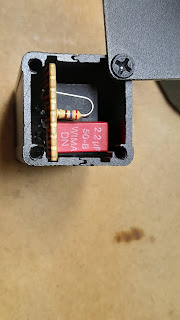Updated 2022-10-15:
Updated 2023-04-21:
Here is a quick diagram of how everything is connected.
The Microphone is a condenser mic, an AKG CK47 with a HM1000 mount HEIL GM with the HC5 selected, which goes into a
dbx286s. From there it goes through an isolation transformer and then into the
ACC1 port of the ICOM. There is no Mic connected at the front and as such PTT is also
through ACC1.
NOTE:
If you want to use the VOX you're out of luck, it looks like that by going through the ACC port the audio is by-passing the analog audio circuitry, hence VOX won't work with this setup.
I did get asked as to "WHY" I've been doing it this way?
Well, my reasons are:
- The attenuator is there to be able to limit the Audio Voltage ingress into the radio (i.e. as to not to overdrive the transceivers audio input stage). It is a bit of an insurance to not have the input stage of the transceiver to flat line.
- Using an isolation transformer is to isolate the external Audio circuitry (dBx) from the transceiver to avoid ground loops and associated issues (HUM).
The dbx286s is setup as followed:
- Mic Preamp
+45dB+50dBPhantom Power- 80Hz high-pass
- Compressor
- Drive
75 - Density
5.55 - De-Esser
- Frequency 4k
- Threshold 2
- Enhancer
- LF Detail
2.57.5 - HF Detail 10
- Expander/Gate
- Threshold
-28-15 - Ratio
5.1:12:1 - Output
- -0 dB
Please note this configuration suits me, i.e. it is for my voice profile, it might not suit your voice and should only be seen as a setup guide.
Here is a picture of the isolation transformer with attenuator. The input is from the dbx and the output goes to the ACC1 port, Pins 4 and 2. The transformer I used is an old line isolator for Telephone modems, an ETAL-P1200. I have a few more isolators from old Telecom exchanges but, they are a bit bigger and didn't fit into the case I've had laying around. Also, I took the easy way out in cabling the isolator (not enough space in the case), the doco for the P1200 does show us how to use it properly.
To connect to the ICOM, I wired a DIN 8 pin to connect to the ACC1 port as followed:
- Pin 4 (Audio input) and Pin 2 (GND),
- Pin 3 (PTT) and Pin 2 (GND) using a
handfootswitch.
Here is an extract from the ICOM manual.
And here is the new audio profile for the IC-7610 with the AKG HEIL GM5 mic.
Transceiver Setup:
- TX SSB Setup
- TBW (NAR) 200-2500 (TX-BW 2K3) prefered
- TBW (MID) 100-2700 (TX-BW 2K6)
- TBW (WIDE) 100-2900 (TX-BW 2K8)
- TX Treble
+5-2 - TX Bass
-30 - MOD INPUT
- ACC MOD LEVEL
20%15% - DATA OFF MOD MIC, ACC <-- MIC needed for VOICE TX
- COMP
- Level
36 - TBW Depends on the mood. (see TX SSB Setup)
Below are a few pics of a second unit I've build. Which, according to the ETAL documentation has better audio transfer characteristics.
The new interface is now connected to the ICOM IC-7610 and the old interface to the ICOM IC-9700. By splitting the output of the dbx, I'm able to use a single Mike for either radio. However, each Radio has its own PTT though.











No comments:
Post a Comment